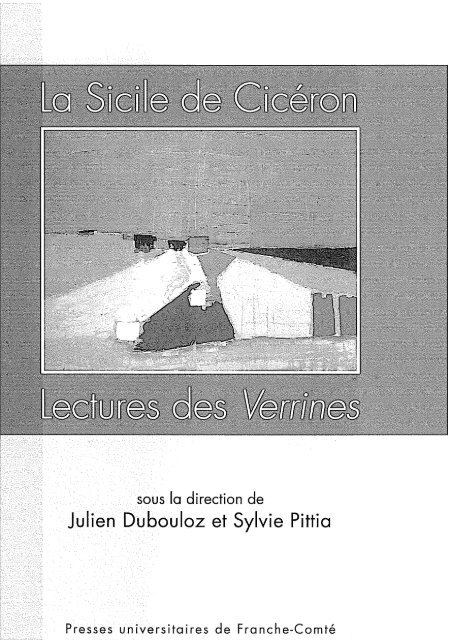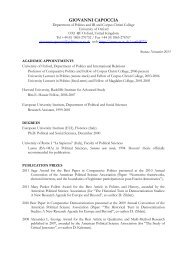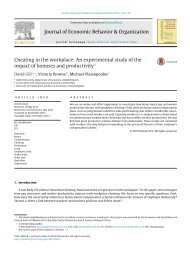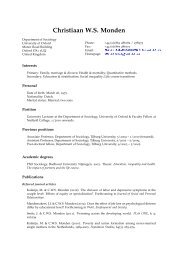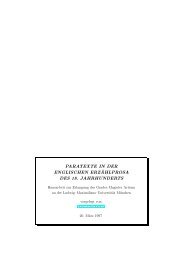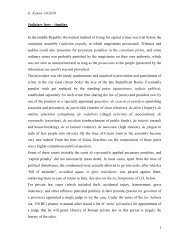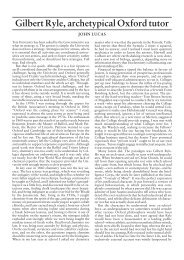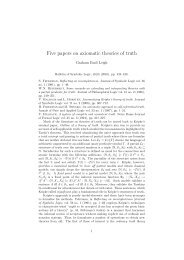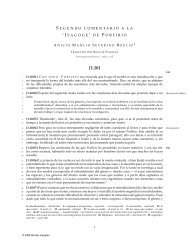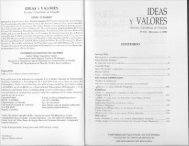Julien Dubouloz et Sylvie Pittia - Personal Pages Index
Julien Dubouloz et Sylvie Pittia - Personal Pages Index
Julien Dubouloz et Sylvie Pittia - Personal Pages Index
Create successful ePaper yourself
Turn your PDF publications into a flip-book with our unique Google optimized e-Paper software.
sous Ia direction de<br />
<strong>Julien</strong> <strong>Dubouloz</strong> <strong>et</strong> <strong>Sylvie</strong> <strong>Pittia</strong><br />
Presses universitaires de Franche-Comte
La Sicile de Ciceron, Lectures des Verrines, 245-271<br />
CICERONIAN SICILY : THE EPIGRAPHIC DIMENSION<br />
Jonathan R.W. PRAG<br />
Merton College, Oxford<br />
Sicilian epigraphy is neither widely, nor easily studied 1 • The primary -reason<br />
for this is the lack of an up-to-date corpus, although several excellent thematic and<br />
museum corpora do exist 2 • This absence contributes to the only partially correct<br />
view that Sicily is epigraphically barren 3 • One basic aim of this paper is therefore to<br />
present an overview of the material pertinent to the period of the Republican<br />
province, loosely defined as the last three centuries BC. Such an overview is one<br />
necessary part of making sense of the Verrines, not least so that we might increase<br />
our knowledge of the Sicilian context with which the speeches are so often<br />
concerned. In certain respects, this paper is intended as a companion piece to the<br />
archaeological overview recently provided by Roger Wilson 4 •<br />
1. I am most grateful to <strong>Sylvie</strong> <strong>Pittia</strong> for the invitation to participate and the efficient organisation of the<br />
colloquium and to <strong>Julien</strong> <strong>Dubouloz</strong> for spotting my mistakes; and to the Centre Gustave Glatz for<br />
financial assistance. The work presented here has benefitted above all from the earlier support of<br />
University College London graduate school. .<br />
2. Introduction to Sicilian epigraphy: GULLETT A 1999; see further the quinquennial survey articles in<br />
Kokalos and the relevant sections of AE, Bull. ep. and SEG. Corpora exist for the museums of Palermo,<br />
Termini Imerese and Catania, as well as of the material found on Lipari; archaic Greek inscriptions<br />
have been collected by R. Arena in Iscrizioni greclze arclwiclze di Sicilia e Magna Grecitz (1, Pisa, 1994,<br />
work is ongoing); dialectical Greek inscriptions in DUBOIS 1989. GIL 10.6976-7493 and JG 14.1-599<br />
remain fundamental, but severely outdated. Phoenicia-Punic epigraphy, some of which is relevant to this<br />
period, is mostly collected in AMADASI Guzzo 1967 and 1986.<br />
3. Davies {2003, p. 338) has characterized Syracuse as «intermittently democratic but epigraphically<br />
inert». Without full publication this is hard to quantify.<br />
4. WILSON 2000.
Cicero11iall SiLily: The Epigraphic Dimwsioll 247<br />
excessively artificial. It is however worth considering wh<strong>et</strong>her the underlying<br />
premise involves giving priority to one or the other: it has probably been the<br />
more traditional pattern in Ancient History to proceed from the literature to the<br />
epigraphy.<br />
3. Similar to approach 2, we can try to use the epigraphic data or the Verrines to<br />
provide relevant, parallel, or illustrative material for the other in order to broaden the<br />
picture. This is a less narrowly specific activity than approach 2, but the agenda is still<br />
d<strong>et</strong>ermined by whichever
Ciceronian Sidly: The Epigraphic Dimension 249<br />
illustrate or correct- and they can only be so used by virtue of the existing<br />
narratives. P. Gardner attacked Jow<strong>et</strong>t's emphasis on literature alone, noting that<br />
corrections from inscriptions to historical fact are but a small part of the epigraphic<br />
contribution, the greater being the fields where the ancient writers are silent; he<br />
himself undertook several studies based upon series of epigraphic texts. M. Cary,<br />
while accepting that one cannot dispense with literary sources (the «flesh and blood»<br />
of ancient history), non<strong>et</strong>heless believed epigraphic documents to be «objective», in<br />
contrast to the subjective literary texts. M. N. Tod combined the views of Gardner and<br />
Cary, arguing that epigraphy is objective and that it covers fields which the literary<br />
texts ignore. However, he also agreed that although history can be written from<br />
literary texts alone, the same cannot be done from epigraphic texts alone : for this<br />
reason, the two sources are inextricably intertwined, not mutually exclusive.<br />
Throughout this debate, the proximity of epigraphic documents to the actual events<br />
and the continuous increase in known epigraphic material are both regularly c;ited as<br />
factors in epigraphy's favour 15 •<br />
Jow<strong>et</strong>t's distinction b<strong>et</strong>ween «history,, and
250 follathall R. W. Prag<br />
J. Ma, is that while literary narratives provide the general and the framework,<br />
epigraphy can serve to produce« a closely textured history», which can mesh with the<br />
narrative record 19 • It is no c.oincidence that epigraphy has served above all in the areas<br />
of social and economic history and in local and provincial history, where in general<br />
literary history is of less direct application, or wholly absent. This brings out the very<br />
unusualness of the situation presented by the Verrines, namely that the Verrines do not<br />
provide us with a typical narrative framework, but they do provide an extensive<br />
literary source on Roman Republican Sicily, which runs parallel to the epigraphy. It is<br />
for this reason that the m<strong>et</strong>hodological questions posed here seem particularly<br />
pertinent, although I do not think that they are in any way restricted to this case.<br />
I do not intend to explore this question further in this paper, but I raise it<br />
here because Ciceronian Sicily seems one particularly apt area for a serious case study.<br />
The rest of this paper will combine a preliminary case study of these issues with a<br />
survey of the potential of epigraphy for the study of Ciceronian _Sicily and the<br />
Verrines, proceeding through each of the five m<strong>et</strong>hodological avenues outlined above.<br />
EPIGRAPHY IN CICERO'S VERRINES<br />
Cicero cites epigraphic material rather more frequently than most ancient<br />
writers 20 • In light of the recent emphasis upon documentary evidence in the Veri·ines<br />
by S. Butler, the fact that Cicero explicitly mentions at least ten inscriptions in the<br />
Verrines (of which at least two in Rome), as well as graffiti in Syracuse, should come as<br />
no surprise 21 • However, this relatively high number (balanced by the length of the<br />
19. ROBERT 1961, p. 463: "II s'agit ordinairement d'une histoire locale, reliee a l'histoire "generale » par<br />
une phrase d'allusion », cf. !viA 2000, p. 12.<br />
20. CHEVALI..IER 1972, p. 12 counts 66 instances.<br />
21. R<strong>et</strong>urn of booty to Segesta from Carthage by Scipio JEmilianus Africanus in 146 (\fer. 4.74) and to<br />
Engyium (Ver. 4.97; 5.186), cf. Tyndaris (Ver. 4.84; 5.185), Agrigentum (Ver. 4.73; 4.93), Gela<br />
(Ver. 4.73), Thermae (Ver. 2.85-87; 4.73); honorific decree on bronze of hospitium publicum<br />
(Syracuse) for L. and M. Tullius Cicero (Ver. 4.145); honorific decree on bronze (Them1ae) for<br />
Sthenius, taken by Cicero to Rome (Ver. 2.112); honorific inscription for Verres, Syracuse (Ver. 2.154,<br />
cf. Ver. 2.137-153 without explicit mention of inscriptions) ; inscribed statue bases in Rome s<strong>et</strong> up by the<br />
Sicilians (Ver. 2.114; 2.150; 2.154; 2.167-168); artist's signature on a silver statue of Apollo,<br />
Agrigentum (Ver. 4.93); silver Cupid, dedicated at Eryx by Verres, bearing Sthenius's name (Ver.<br />
2.115); Greek inscription on base of a statue of Sappho in Syracuse prytaneion (Ver. 4.127); ivory<br />
tusks from the sanctuary ofJuno on Melita, restored by Masinissa with a Punic inscription (Ver. 4.103);<br />
graffiti lampooning Pipa, wife of JEschrion the Syracusan (\fer. 3.77). BUTLER 2002, p. 48-51 has a<br />
comparable list.<br />
La Sicile de Ciceron, Lectures des Verrines
Cicero11ian Sidly: The Epigraphic Dimension 251<br />
Verrines) is worth keeping in mind when we are usually so negative about the Sicilian<br />
epigraphic habit. As Butler observes, the bronze honorific decree which the Syracusans<br />
dashed off for Cicero and his cousin suggests, on the contrary, «a rather obsessive<br />
epigraphic habit » 22 • Only in the case of the dedications s<strong>et</strong> up by Scipio in 146 do we<br />
have the inscription described (almost) 23 , but parallel material can non<strong>et</strong>heless be<br />
offered in almost every case. However, the search for parallels, as for example in the<br />
case of statues commemorating patronage and soteria, belongs under approach 3<br />
above, to which we shall come shortly 24 •<br />
Two points are worth making on the basis of Cicero's citations. Firstly, that<br />
several of the categories of inscription on which Cicero spends the most time are<br />
either Roman-created or Roman-inspired. This is however one of the least well<br />
attested categories of epigraphic material from Republican Sicily. We could either<br />
explain this discrepancy as being due to Cicero's own very partial focus, or else<br />
dismiss it as a mere accident of survival. Either way, it should give pause for tl)ought.<br />
Secondly, although the surviving epigraphic material of this period in Sicily, created<br />
by Sicilians, is almost entirely Greek (which is in line with what Cicero says here and<br />
elsewhere about Greek linguistic practice on the island) 2 5, non<strong>et</strong>heless, the Sicilians<br />
erected Latin texts in Rome and elsewhere (as we know from a surviving epigraphic<br />
text at Auximum) and the Romans erected Latin texts in Sicily (starting with a<br />
milestone of252) 26 •<br />
EPIGRAPHIC POINTS OF CONTACT WITH THE VERRINES<br />
The search for more information on a particular person, institution, event <strong>et</strong>c.,<br />
across the different data s<strong>et</strong>s is a rather limited activity, but an important one<br />
non<strong>et</strong>heless for explicating a text. Direct overlaps are quite infrequent, for two reasons<br />
touched on already: the total body of epigraphic material is quite limited and in<br />
particular the surviving Roman-oriented or -inspired material is extremely limited, in<br />
contrast to the Ciceronian focus.<br />
22. BUTLER 2002, p. 37, conlm DAVIES 2003, p. 338. On the Sicilian epigraphic habit, PRAG 2002.<br />
23. Two texts from Thermae Himeraeae, both imperial period copies: JG 14.315 = ILS 8769 = Syll.' 677;<br />
NSA 1935, p. 201-202. Both republished in BRUGNONE 1974, p. 223-229, nos. 3-4.<br />
24. These particular Sicilian examples are discussed and contextualized in TANNER 2000, p. 32-35 and<br />
p. 40-41.<br />
25. e.g. Ver. 2.50; 2.154; 3.84; 4.127; 4.147; 5.148, cf. allusions to Greek institutions, e.g. \fer. 2.36-37;<br />
2.50 ; 2.54 ; 4.50.<br />
26. Auximum inscription: GIL 9.5834 = ILS 926; Corleone milestone of Aurelius Cotta: ILLRP 1277<br />
GIL I 0 .2877 (now PRAG 2006).<br />
La Sidle de Ciceron, Lectures des Verrines
Cicerolliall Sidly: The Epigraphic Dimellsioll 253<br />
Specific events, such as the slave wars or Norbanus's activities in the Social<br />
War also feature in both types of materiaP 3 • Occasionally, specific institutions appear<br />
in both, such as the Syracusan OJ.Hjli.noA.oc;, referred to by Cicero and attested in the cult<br />
inscriptions from Buscemi near Acrae 3 \ or the more problematic case of the<br />
Agrigentine cn)yKA.rp:oc;, described by Cicero and visible in a proxeny decree on<br />
bronze of the Agrigentines 35 • As with individuals, one institution for which we might<br />
expect evidence is the le.;-,: Hieronica, but the only possible epigraphic reference lies in a<br />
fragmentary honorific decree from Agrigentum, which may conceivably contain a<br />
reference to the procedure of anoyp[a
254 ]o11athatz R. W. Prag<br />
Instances of real, direct illumination of Cicero's text by the epigraphic material<br />
are rare: one such example is Cicero's passing reference to the cognatio of Centuripae<br />
with Rome, for which we now have the act of« kinship diplomacy» with Lanuvium and<br />
Rome attested by a fragmentary decree of Centuripae3 9 •<br />
EPIGRAPHIC PARALLELS<br />
A more constructive and wide-ranging approach to the epigraphy is to use<br />
epigraphic material in order to fill in the background to things we encounter in the<br />
Verrines. The possibilities increase significantly at this point. For example, although,<br />
as we saw above, the honorific decrees which Cicero describes in the case of both<br />
Sthenius of Thermae and himself do not survive, non<strong>et</strong>heless, we can generate a clear<br />
idea of the sort of text and object involved, as well as of other individuals engaged in<br />
these kinds of activities, from the documents which do survive. Relevant epigraphic<br />
texts on bronze include a pair of decrees recording the activities of a Syracusan,<br />
Dem<strong>et</strong>rius, son of Diodotus, on behalf of the Agrigentines and the Maltese; honours<br />
for a Roman at Rhegium and the slightly earlier Entella tabl<strong>et</strong> honouring one<br />
Ti. Claudius Antiatas 40 • The case of C. Norbanus, honoured on stone at Rhegium,<br />
serves to bring out a further footnote to the Verrines, namely Cicero's passing<br />
reference to V erres' interaction with Rhegium : Sicilian pra<strong>et</strong>ors apparently acted<br />
across the Straits on a regular basis and this generally went unremarked 41 • The search<br />
for parallels can take us well beyond the Sicilian material, as in the case of the (united)<br />
Sicilian honours for Verres at Rome, for which only one, indirect, Sicilian parallel<br />
survives, that previously cited from Auximum- although this is also important<br />
possible corroborative evidence for Cicero's hint at some sort of provincial assembly<br />
39. \fer. 5.83, cf. 2.163. Decree: SEG 42.837 (text); AE 1990.437 (French trans!.), cf. !'vlANGANARO 1963b<br />
and 1976, p. 87-88 (photo); CEBEILLAC-GERVASONI 1989 (photo).<br />
40. Agrigentines honour Dem<strong>et</strong>rius: IG 14.952; Maltese honour Dem<strong>et</strong>rius: IG 14.953 ; note also two<br />
fragmentary decrees, one from Agrigentum (IG 14.954), the other probably Sicilian (IG 14.955) ; the<br />
Rhegines honour Cn. Aufidius T. f.: IG 14.612; the Entellans honour Ti. Claudius C. f. Antiatas:<br />
Entella IV= Am polo B1 = SEG 30.1120.<br />
41. \fer. 5.47; SEG 1.418 =BUONOCORE 1989, p. 58, no. 11. On governors acting outside their provinces,<br />
LINTOIT 1993, p. 24-27. Magistrates r<strong>et</strong>ained imperium during their r<strong>et</strong>urn to Rome (Cic. Fum. 1.9; Lex<br />
de prouinciis pra<strong>et</strong>oriis, CRAWFORD 1996, 1, no. 12, Cnidos Copy, col. IV, !. 31-39, p. 242, with<br />
commentary p. 265), which renders unproblematic the appeal of Valentia to Verres, as Cicero notes<br />
(\fer. 5.40-41 ). This does not however explain Verres' orders to the Rhegines for timber.<br />
La Sicile de Ciceron, Lectures des Verrines
Ciceronian Sidly: The Epigraphic Dimwsion 255<br />
or council 42 • Non-Sicilian parallels from Italy and the Greek East on the other hand are<br />
abundantl 3 •<br />
In an attempt to contextualize and broaden our understanding of the lex<br />
Hieronica, Sicilian taxation and agriculture we can make use of both the financial<br />
inscriptions from Tauromenium and the cadastral inscription(s) from Halaesa· 14 • The<br />
former cast light on the ways in which local civic finances operated, only very<br />
indirectly suggested by Cicero, and indicate the importance of produce other than<br />
grain, such as pulses, as well as the value of timber as a natural resource. The latter<br />
opens a very different window on patterns of land-holding and the organisation of the<br />
locallandscape 45 •<br />
If the search of the epigraphic record for individuals named in the Verrines is<br />
largely unsuccessful, the quest for parallels is much more productive: several Roman<br />
magistrates emerge from the period, in most cases not otherwise directly attested<br />
(although a total of five named and one anonymous for the minimum of 178 years<br />
(i.e. 227 -49) of Republican magistrates in Sicily is hardly impressive)- 16 ; individual<br />
Roman equites and negotiatores are not identifiable in the epigraphic record, but<br />
more generic indications of their presence exist, such as Italic or Latin names and<br />
42. BELL, in this volume, p. 195-200. Besides the Au:'dmum inscription and several passages of Cicero (e.g.<br />
Ver. 2.10-11; 2.103; 2.112; 2.146-148; 2.154; 3.18-19; 3.204; 4.138; Att. 10.12.2), the only direct<br />
evidence for a provincial council is of much later imperial date: IG 14.1078a = ILS 8843 and<br />
Symmachus Ep. 1.17. As SARTORI 1981, p. 404-405 observes, this cannot safely be taken to prove<br />
anything about the earlier period. Karlsson (1993, p. 37-38; 1996, p. 85) has argued for an earlier<br />
Hieronian Kotvov, but the evidence is wholly inconclusive (reference to a Kotvov in IG 14.7 cannot<br />
securely be so restored, cf Bull. ep. 1966.515 and Iv1ANGANARO 2005; the :EtKEAtmiiv coinage<br />
(BUTTREY- ERIM- GROVES- HOLLOWAY 1989, p. 31-33) belongs in a unique wartime context).<br />
43. LINTOTT 1993, p. 41, n. 89-90 and p. 124 (takes the Sicilian case to be certain).<br />
44. Tauromenium accounts: IG 14.422-430; ARANGIO-Rmz- OLIVIERI 1925, no. 13 = SEG 4.48;<br />
MANGANARO 1964a, p. 42-52 (cf Bull. ep. 1966.512); MANGANARO 1964a, p. 53-68 (cf Bull. ep.<br />
1966.512); MANGANARO 1988, p. 155-156 (SEG 38.973A); MANGANARO 1988, p. 156-157 (SEG<br />
38.973B). Halaesa cad aster: IG 14.352 (lost); DIGIOVANNI 1885 (second fragment of the same stone,<br />
also now lost) ; CALDERONE 1961 (SEG 31.825) (not necessarily part of the same stone).<br />
45. Hypoth<strong>et</strong>ical sk<strong>et</strong>ch maps, based upon the inscription, illustrating some of the land-holdings in<br />
ARANGIO-RUIZ - OLIVIERI 1925, no. 2. Bibliography is extensive, but cf esp. MANGANARO 1980,<br />
p. 430-435 and papers in PRESTIANNI GIALLOMBARDO 1998.<br />
46. Cf p. 287-310 for a list of Roman officials attested in Sicily; e.g. ILLRP 1277 = CIL 1'.2877 (C. Aurelius<br />
Cotta, cos. 252, cos. II 248); CIL 10.7258 = 1'.843 (anonymous quaestor propm<strong>et</strong>ore, I'' cent?); CIL<br />
1'.2951 (C. Norbanus (C. f. Balbus), pra<strong>et</strong>or c. 90-c. 86); IG 14.435 (C. Claudius M. f. Marcellus,<br />
pra<strong>et</strong>or 79) ; IG 14.356 (C. Vergilius C. f. Balbus, proquaestor early 60s) ; IG 14.282 (L. Caecilius L. f.<br />
M<strong>et</strong>ellus, quaestor c. 52). Such numbers should make us extremely wary of any arguments based upon<br />
survival or non-survival of evidence.<br />
La Sicile de Ciceron, Lectures des Verrines
Cicero11ian Sidly: The Epigraphic Dime11sion 257<br />
What emerges most clearly from both of the preceding approaches is the<br />
difference in focus b<strong>et</strong>ween the two types of source ; but what should also be obvious is<br />
that we risk missing a great deal if the only questions which we ask are those which are<br />
prompted by the Verrines. Either we must ask questions independently of the sources<br />
(but risk g<strong>et</strong>ting a limited answer), or else we must approach the epigraphy on its own<br />
terms.<br />
SICILIAN
258 jonathan R. W. Prag<br />
alternative epigraphic view of the island in this period (fig. 3, p. 271) 55 • The differences<br />
are worth plotting if only as a reminder of the differently partial nature of each s<strong>et</strong> of<br />
evidence.<br />
The most active towns epigraphically in this period (or at least those with the<br />
best epigraphic survival rates) are, in descending order, Syracuse, Tauromenium,<br />
Acrae, Lilybaeum, Segesta and Halaesa. However, the Syracuse and Acrae material<br />
mostly belongs to the beginning of this period (much appears to be Hieronian), the<br />
Tauromenium material is dominated by the large dossier of civic records, and much of<br />
the Lilybaeum material belongs at the end of the period (Augustan). In this regard, the<br />
Segesta and Halaesa material is perhaps the most interesting. Neither site underwent<br />
significant occupation after antiquity and in both cases the agora has been excavated 56 :<br />
the image of an active civic centre which the material presents is therefore perhaps<br />
reassuring (contrast however the absence of material from I<strong>et</strong>as I Monte Iato, also<br />
well-excavated and not reoccupied) and potentially paradigmatic : formal agora, statue<br />
bases, honorifics, gymnasium-related material, building inscriptions, the presence of<br />
Romans <strong>et</strong>c.<br />
Cicero naturally has specific interests and biases. The epigraphy has a s<strong>et</strong> of<br />
biases of its own, but the concerns which the epigraphy represents are independent<br />
of those of Cicero. Besides funerary epigraphy, the principal categories of epigraphic<br />
material are: public honorifics and other public inscriptions, associated, for<br />
example, with the gymnasium ; a significant number of lists of civic magistrates ;<br />
occasional building inscriptions; and a range of religious dedications 57 • There is of<br />
course a range of anomalous inscriptions - the difficulty in these cases is to know<br />
how to integrate them into any sort of overall picture or context, either Ciceronian<br />
or Sicilian: an oracular text from near Acrae 58 ; a text allocating mark<strong>et</strong>-stalls,<br />
perhaps in the context of a festival (Acrae) 59 ; the Halaesa cadastral inscription noted<br />
55. SGDI 2580, variously dated late 3'J or early 2"J cent (cf Bull. ep. 1994.432) ; for the Sicilian section,<br />
MANGANARO 1964b, p. 419-429; 1996, p. 131-138 (although attempts to infer status in relation to<br />
Rome should be treated with caution).<br />
56. Halaesa: CARETTONI 1961 ; SCIBONA 1971; WILSON 1990, p. 46-48; Segesta: MICHEL!Nl 1997;<br />
VAGGIOU 1997; DECESARE- PARRA 2000 (work is ongoing); the epigraphic material is collected in DE<br />
Vmo 1991.<br />
57. Examples of public honorifics: Apollonia IS. Fratello: IG 14.359; Halaesa: IG 14.353; 14.354;<br />
14.356 and SEG 37.759; Haluntium: IG 14.366; Lilybaeum: IG 14.273 and SEG 34.951; Phintias:<br />
IG 14.259; Segesta IG 14.288(1); Tauromenium: IG 14.434; SEG 32.936; 32.937.<br />
58. SEG 31.822; lvlANGANARO 1981; PAIU.'E 1986.<br />
59. IG 14.217; MANGANARO 2004.<br />
La Sicile de Ciceron, Lectures des Verrines
Ciceronian Sidly: The Epigraphic Dimension 259<br />
earlier, with a mode of dispute resolution not dissimilar to the procedures outlined in<br />
the Nakone inscription from among the Entella tabl<strong>et</strong>s 60 ; the painted library catalogue<br />
from Tauromenium 61 ; or the Tauromenium financial accounts 62 • No less problematic<br />
are the infrequent, 3rr1-cent. Oscan texts from Messana 63 ; or the occasional Punic text<br />
and graffito in the west of the islandM. The difficulty of generalizing from single<br />
instances is constantly present (the same difficulty of course applies to a unique<br />
literary text such as Cicero's).<br />
Outward looking inscriptions, such as the consular Fasti and Roman calendar<br />
from Tauromenium 65 , or the record of the kinship embassy from Centuripae 66<br />
mostly belong to the very end of this period. By contrast, the infrequent Latin<br />
epigraphy is mostly the work of outsiders making statements of either a public<br />
and I or a religious nature, reflecting the activities of Roman magistrates, or<br />
dedications at sanctuaries 67 , or the familiar category of negotiatores inscriptions 68 ,<br />
outsiders talking to outsiders in front of locals. It is only at the end of the period that<br />
Latin funerary epigraphy begins to appear 69 • There are however a few exceptions,<br />
such as the inscription of Cn. Host(ilius ?) from I<strong>et</strong>as (Monte Iato), found in<br />
60. Cf n. 44; SEG 31.825, for the relevant part of the Halaesa inscription; Nakone inscription: SEG<br />
30.1119, cf AMPOLO 2001.<br />
61. BLANCK 1997.<br />
62. Cf n. 44.<br />
63. IvlASTELLONI 2005; CRAWFORD, in this volume, p. 273-275. The texts on stone are: VETTER 1953,<br />
nos. 196 ; 197 and 197a; PARLANGELI1956, no. 1B (separate text from V<strong>et</strong>ter 1953, no. 196).<br />
64. Punic texts of the period from Eryx (or possibly N. African): BISI 1969a; Eryx (lost): CIS 1.135<br />
= Al>!ADASI GUZZO 1967, Sic. Pun. 1 ; Lilybaeum: CIS 1.138 = AMADASI Guzzo 1967, Sic. Pun. 5;<br />
AMADASIGUZZO 1993; Lilybaeum (or possibly Carthage): AMADASIGUZZO 1967, Sic. Pun. 4 and Sic.<br />
Pun. 10; graffito on Isola Favignana: BISI 1969b; Panhormus: CIS 1.134 = AMADASI GUZZO 1967,<br />
Sic. Neo. 1 = DESJ:t,!ONE 1998, p. 433, E2; Selinus: GARBINI1965, p. 206-210.<br />
65. Inscr. It. 13.2, p. 547, tav. 89; MANGANARO 1963c, p. 13-19; 1964a, p. 38-39; BACCI 1984-1985,<br />
p. 724, tav. CLIX; RUCK 1996. PIN ZONE in this volume, p. 103.<br />
66. Cfn. 39.<br />
67. Cf n. 31, for Norbanus and Cotta; to Apollo (Halaesa ?) : CIL 10.7265 = 1 1 .2219; to Venus Erycina<br />
(Eryx): CIL 10.7253 = 1 1 .2221; 10.7254 = 1 1 .2222; 10.7255 = 1 1 .2223; to Hercules (S. Stefano): CIL<br />
10.7197 = 1 1 .2220; anon. (Syracuse): CIL 1 1 .3429.<br />
68. Cf n. 47.<br />
69. One of the earliest is probably an unpublished funerary stele from the Syracuse necropolis of Canalicchio,<br />
now on display on the upper floor of Syracuse museum (inv. 43118) with a relief carving of a plough on<br />
the upper half, cf WILSON 1990, p. 356 n. 97.<br />
La Sicile de Ciceron, Lectures des Verrines
Cicero11imz Sidly: The Epigraphic Dime11sio11 261<br />
different sources can throw on it. It remains true that the question must be one which<br />
the evidence is capable of addressing and the ability to frame such questions generally<br />
presumes a certain level of familiarity with the available evidence. One obvious<br />
example of this and where it has perhaps been applied most productively to date, is in<br />
the study of Roman migration into the island 73 •<br />
I conclude this paper with the briefest of summaries of another example, to<br />
which I shall r<strong>et</strong>urn in more d<strong>et</strong>ail in a forthcoming article.<br />
In the Fifth Verrine, Cicero attacks Verres' military record in defence of the<br />
island. In doing so, Cicero alludes to the use of local Sicilian manpower, both by sea<br />
and on land. However, while he implies a regular practice, Cicero is, in the speech,<br />
only concerned with one instance of abuse and failure on Verres' part' 4 • On the other<br />
hand, several dedications, both by the garrison at Eryx and elsewhere (especially at<br />
Halaesa), suggest a more widespread and regular level of local military activity, as do<br />
inscribed glandes and various forms of naval commemoration 75 • It is however<br />
possible to suggest an even broader context, in the light of the civic epigraphic<br />
material and the emphasis upon civic identity and civic life already demonstrated.<br />
Epigraphy, but by no means epigraphy alone, attests to the existence of gymnasia<br />
across the island in this period 76 • The link b<strong>et</strong>ween these two elements is made<br />
possible through one particular inscription, from Soluntum (IG 14.311), in which<br />
local soldiers honour a gymnasiarch. In the light of the discussion of the role played<br />
by the gymnasium which has taken place, especially in relation to Macedonia and<br />
Asia Minor and the relationship of the gymnasium to citizen soldieryn, it is tempting<br />
73. PINZONE 1999 with earlier bibliography.<br />
74. Cic. Ver. 5.43-157 passim and esp. Ver. 5.43; 5.49-63; 5.86; 5.93; 5.133, cf 4.21; 4.76; 4.150.<br />
75. Epigraphic texts: CIL 10.7258 = 1°.843 = ILLRP 446 (garrison at Eryx honours quaestor); IG 14.282<br />
(Segestan at Eryx); IG 14.311 (local troops from Soluntum); IG 14.355 (Halaesans record service at<br />
Eryx); IG 14.401 (Messana, if the reading NA 1"POI = «temple guards» is accepted); AE 1973.265<br />
(Halaesans <strong>et</strong> a/. serving at sea under Roman command). For the evidence of local troops provided by<br />
glandes, cf the survey in MANGANARO 1999, p. 27-33. For naval activity, cf esp. the stone rostra found<br />
at Segesta in BECHTOLD 1997 and those on display in the museum at Tyndaris, in SPIGO 2005, p. 73-74,<br />
fig. 3.<br />
76. Epigraphic attestations of gymnasia include: JG 14.213 (Acrae); IG 14.240 (N<strong>et</strong>um); IG 14.256<br />
(Phintias); IG 14.311 (Soluntum); IG 14.349 (Cephaloedium?); IG 14.369-371; IG 14.422 and<br />
14.432 (Tauromenium) ; IG 14.456 (Catina; the word is restored in KORHONEN 2004, no. 2); SEG<br />
26.1060 (Haluntium); SEG 41.826 (Segesta); SEG 46.1252 (Agrigentum); Bull. ep. 1953.279<br />
(Centuripae); Bull. ep. 1964.629 (Helorus); ivlA.c'IGANARO 1999, no. 58 (Syracuse; a restoration), cf<br />
MORETTI 1976, p. 182; MANGANARO 1980, p. 445-446; CORDIANO 1997, p. 88-89.<br />
77. Esp. GAUTHIER 1995.<br />
La Sici/e de Ciceron, Lectures des Verrines
262 ]o11atha11 R. W. Prag<br />
to suggest that Rome made use of existing local institutions (as they did in the sphere<br />
of taxation) in order to garrison the island- another inscription, from N<strong>et</strong>um,<br />
suggests what has been argued elsewhere by F. Ferruti and G. Cordiano, that gymnasia<br />
were fostered by Hieron II, quite possibly with manpower in mindi 8 • By doing so, the<br />
Romans in fact fostered the further growth of a lively civic hellenistic culture, some of<br />
the evidence for which we have already seen.<br />
There is not the space to explore this particular suggestion in more d<strong>et</strong>ail here;<br />
my point is rather that to g<strong>et</strong> the most from the epigraphy- or from Cicero -we must<br />
engage in a more complex process of dialogue b<strong>et</strong>ween the different stories told by the<br />
different s<strong>et</strong>s of material than that suggested in the earlier parts of this paper. But<br />
perhaps that was already obvious.<br />
fuV!ADASI Guzzo M.G., Le iscrizionifenicie e puniche delle colonie in Occidel!te, Rome, 1967.<br />
fuV!ADASI Guzzo M.G., Scavi a Mozia. Le iscrizioni, Rome, 1986.<br />
fuV!ADASI Guzzo M.G.,« Un'iscrizione punica dalla necropoli di Lilibeo »,in C. A. DiStefano<br />
(dir.), Lilibeo punica, Marsala, 1993, p. 61-62.<br />
fuV!POLO C., « Nakone: come fu risolta una latta civile>>, Da zm'mztica citta di Sicilia: i decr<strong>et</strong>i di<br />
Entella e Nakone (Catalogo della mostra, Pisa, 2001), Pisa, 2001, p. 203-205.<br />
ARANGIO-RUIZ V. & A. OLIVERI (ed.), Inscriptio11es Graecae Siciliae <strong>et</strong> infimae Italiae ad •ius<br />
perti11entes, Milano, 1925 [Chicago, 1980].<br />
BACCI G. M., «Taormina (1984)- Scavi e restauri presso le Terme Romane >>, Kokalos, 30-31,<br />
1984-1985,p. 722-725.<br />
BECHTOLD B., «Una villa ellenistico-romana sull'acropoli sud di Segesta », Atti delle secmzde<br />
giomate intemazionali di studi sull'area elima, Pisa- Gibellina, 1997, 1, p. 85-110.<br />
BISI A.M., « Frammento di stela votiva con iscrizione punica da Erice >>, AION, 19, 1969a,<br />
p. 112-116.<br />
BISI A. M., « Iscrizione neo-punica inedita da Favignana >>, AION, 19, 1969b, p. 555-558.<br />
78. IG 14.240; CORDIANO 1997, p. 105-106; FERRUTI2004.<br />
La Sicile de Ciceron, Lectures des Verrines
Ciceronian Sicily: The Epigraphic Dimension 263<br />
BLANCK H.,« Un nuovo framrnento del 'catalogo' della biblioteca di Tauromenion », PP, 52,<br />
1997, p. 241-255.<br />
BLOESCH H., « Wie hiess die Stadt der Iaitiner? >>, Kokalos, 17, 1971, p. 26-32.<br />
BODEL J. (dir.), Epigraphic Evidence. Ancient History from Inscriptions, London, 2001.<br />
BRUGNONE A., , Supplementa Italica, n. s., 5, 1989, p. 29-84.<br />
BUTLERS., The Hand of Cicero, London- New York, 2002.<br />
BUTTREY T.V., K. T. ERIM, T. D. GROVES & R. R. HOLLOWAY, Morgatztina Studies, 2, The Coilzs,<br />
Princ<strong>et</strong>on (NJ), 1989.<br />
CALABI LIMENTANI I., Epigrafia latina, Milan, 1991".<br />
CALDERONE S., >, Kokalos, 7, 1961, p. 124-136.<br />
CALDERONE S., >, Quademi del/'Istituto di<br />
Archeologia della Faco/tiz di L<strong>et</strong>tere e Filosofia dell'Universita di Messina, 1, 1985,<br />
p. 13-18.<br />
CARETIONI G., >, NSA, 15, 1961,<br />
p. 266-321.<br />
CARY M., The Documentary Sources of Greek History, Oxford, 1927.<br />
CEBEILLAC-GERV ASONI M., >, in C. Castillo (dir.), Novedades de Epigrafia juridica romatza, Pamplona,<br />
1989, p. 103-114.<br />
CHEVALLIER R., Epigraphie <strong>et</strong> /itterature iz Rome, Faenza, 1972.<br />
CORDANO F., , in GULLETIA<br />
1999, 1, p. 149-158.<br />
CORDIANO G., Lagi111zasiarchia nelle >, dell'Ocddente Mediterratzeo antico, Pisa, 1997.<br />
CRAWFORD M. H., Roman Statutes, BICS Suppl., 64, London, 1996.<br />
DAEHN H. S., Studia I<strong>et</strong>ilza, 3, Die Gebiiude an der Westseite der Agora von Iaitas, Zurich, 1991.<br />
DAVIES J. K., , in M. Brosius (dir.), Ancient Archives and<br />
Archival Traditions. Concepts of Record-Keeping in the Ancient v\Torld, Oxford, 2003,<br />
p. 323-343.<br />
La Sici/e de Ci<strong>et</strong>iron, Lectures des Verrines
264 Jonatha11 R. iV. Prag<br />
DE CESARE M. & M. C. PARRA, , Atti delle terze giomate<br />
intemazionali di studi sull'area elima, Pisa- Gibellina, 2000, 1, p. 273-286.<br />
DE SL\10NE R., >, Palermo punica (Catalogo della mostra, Palermo, 1995-1996),<br />
Palermo, 1998, p. 428-434.<br />
DE VIDO S., >, ASNP, 21, 1991,<br />
p. 929-994.<br />
DIGIOVANNI V., ,<br />
Archivio Storico Sicilimzo, 10, 1885, p. 123-129.<br />
DISTEFANO C. A. (dir.), Lilibeo: testimonianze archeologiche dal IV sec. a. C. al V sec. d. C.,<br />
Palermo, 1984.<br />
DI VEROLI P., « Nuovi eponimi della Sicilia ellenistica >>, ZPE, llO, 1996, p. 309-310.<br />
DUBOIS L., Inscriptio11s grecques dialectales de Sidle, CEFR, ll9, Rome, 1989.<br />
FERRUTI F., ,in B. Bechtold (dir.), La 11ecropoli di<br />
Lilybaewn, Palermo, 1999, p. 394-457.<br />
GABBA E., , Kokalos, 46,2004, p. 31-73.<br />
GRIFFIN M.,
Ciceronian Sidly: The Epigraphic Dimension 265<br />
GULLEITA M. I. (dir.), Sicilia epigraphica, ASNP, ser. 4, quad. 1-2, Pisa, 1999.<br />
HIGBIE C., «Stelae and Spoils: Craterus and the Use of Inscriptions in Ancient Scholarship >>,<br />
TAPlzA, 129, 1999, p. 43-83.<br />
HINZ V., Der Kult von Dem<strong>et</strong>er und Kore at(( Sizilien wzd in der Magna Graecia, Wiesbaden,<br />
1998.<br />
ISLER H. P., >, AK, 22, 1979, p. 59-71.<br />
ISLER H. P., «Monte Jato : Ia diciannovesirna campagna di scavo >>, Sicilia Archeologica, 69-70,<br />
1989, p. 7-24.<br />
ISLER H. P., >, AK, 37, 1994, p. 31-42.<br />
JOWEIT B., Thucydides. Translated into English, to which is Prefi-r:ed an Essay on Inscriptions and<br />
a Note 011 the Geography ofThucydides, Oxford, 1900 1 •<br />
KARLSSON L., ,ActaHyp, 5,1993, p. 31-51.<br />
KARLSSON L., «The Altar of Hieron at Syracuse n, ORom, 21, 1996, p. 83-87.<br />
KORHONEN K., Le iscrizioni delMuseo civico di Catania. Storia delle collezioni, wltura epigrafica,<br />
edizione, Helsinki, 2004.<br />
LINTOIT A. W., Imperium Romanum. Politics and Administration, London, 1993.<br />
MAJ., Antiochos III and the Cities o_(Westem Asia Minor, Oxford, 2000.<br />
MANGANARO G., >, Kokalos, 9, 1963a, p. 205-220.<br />
MANGANARO G.,>, RAAN, 38, 1963b, p. 23-44.<br />
MANGANARO G.,« Tauromenitana: un calendario romano di Tauromenion >>, AC, 15, 1963c,<br />
p. 13-31.<br />
MANGANARO G., >,<br />
Cronache di Archeologia e Storia dell'Arte, 3, 1964a, p. 38-68.<br />
MANGANARO G., >, Histo1ia, 13,<br />
1964b, p. 414-439.<br />
MANGANARO G., , in<br />
A. AlfOldi (dir.), Romische Friihgeschichte, Heidelberg, 1976, p. 83-96.<br />
MANGANARO G., >, Cronache di Archeologia e Storia<br />
dell'Arte, 16, 1977, p. 148-164.<br />
MANGANARO G., «La provincia romana >>, in E. Gabba & G. Vall<strong>et</strong> (dir.), La Sicilia antica,<br />
Naples, 1980,2, 2, p. 415-461.<br />
La Sicile de Ciceron, Lectures des V errines
266 Jonathan R. W. Pmg<br />
MANGANARO G., « L' oracolo di Maie per una carestia in territorio siracusano », ASNP, 11, 1981,<br />
p. 1069-1082.<br />
MANGANARO G., « Mon<strong>et</strong>e e ghiande inscritte degli schiavi ribelli in Sicilia>>, Chiron, 12, 1982,<br />
p. 237-244.<br />
MANGA!"'ARO G., « Le tavole finanziare di Tauromenion »,in D. Knoepfler (dir.), Comptes <strong>et</strong><br />
inventaires dans la cite grecque, Neuchatel- Geneve, 1988, p. 155-190.<br />
MANGANARO G.,
Ciceronian Sicily: The Epigraphic Dimension 267<br />
PARKE H. W., «Further Comments on 'epica religiosa' (ZPE 50, 1983, 1-6), a Sibylline Oracle>>,<br />
ZPE, 63, 1986, p. 47-51.<br />
PARLANGELI 0., « Le iscrizioni osche (mamertine) di Messina>>, Boll<strong>et</strong>tillo del Centro di Studi<br />
Filologici e Li12guistici di Sicilia, 4, 1956, 28-38.<br />
PINZONE A., « L'immigrazione e i suoi riflessi nella storia economica e sociale della Sicilia del II<br />
sec. a. C.>>, in M. Barra Bagnasco, E. De Miro & A. Pinzone (dir.), Magna Grecia e<br />
Sicilia. Stato degli studi e prosp<strong>et</strong>tive di ricerca, Messina, 1999, p. 381-402.<br />
PRAG J. R. W., «Epigraphy by Numbers: Latin and the Epigraphic Culture in Sicily>>, in A. E.<br />
Cooley (dir.), Becoming Roman, Writing Latin?, JRA Suppl., 48, Portsmouth (RI),<br />
2002, p. 15-31.<br />
PRAG J. R. W., «Nouveau regard sur les elites locales de !a Sicile republicaine », Histoire <strong>et</strong><br />
Soci<strong>et</strong>es Rurales, 19,2003, p. 121-131.<br />
PRAG J. R. W., Sicily and the Roman Republic, 241-44 BC: Provi12cialization and Provincial<br />
Identities, Unpublished PhD Dissertation, University of London, 2004.<br />
PRAG J. R. W., «II miliario di Aurelius Cotta (ILLRP 1277): una lapide in contesto >>, Qui12te<br />
giornate intemazionali di studi sull'area elima e la Sicilia occidentale nel contesto<br />
mediterraneo, Pisa, 2006, 2, p. 733-744.<br />
PRESTIANNI GIALLOMBARDO A.M. (dir.), Colloquia alesino (S. Maria delle Palate (Tusa), 7 maggio<br />
1995), Catania, 1998.<br />
PUGLIESE CARRATELLI G.


